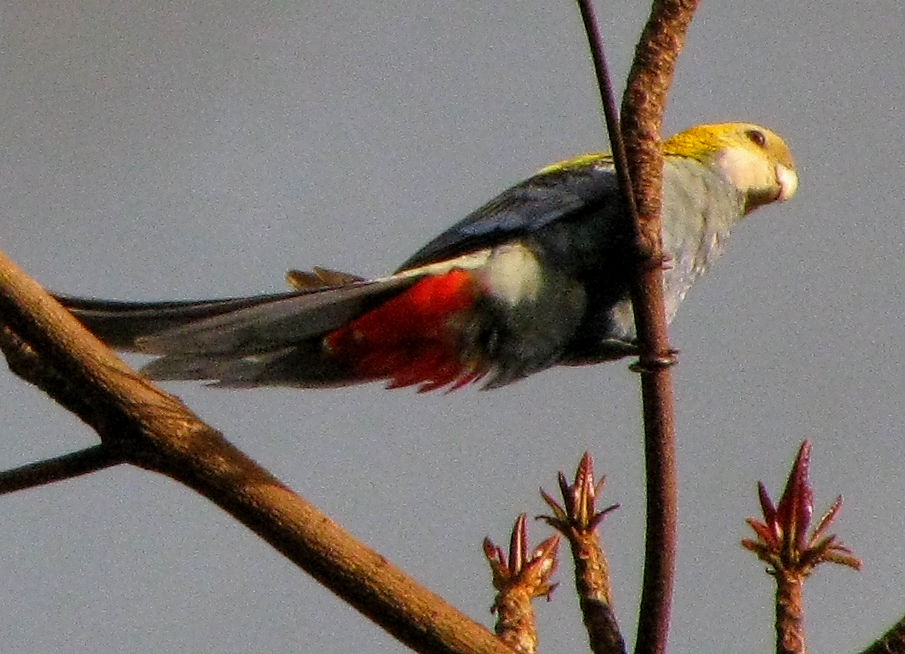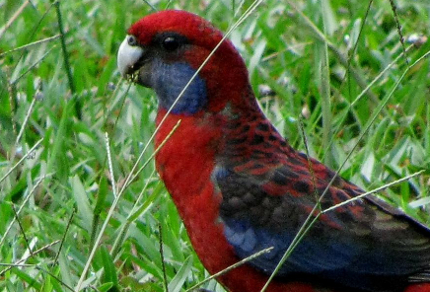A brief downpour awakened me in early morning’s darkness, its thrumming on the metal roof persistent, yet somehow comforting. A few minutes later, my 5 a.m. alarm rang, jolting me into groggy activity. Beyond the cement walls of our rental house, possums hissed and snarled, bush stone-curlews wailed haunting cries, and flying foxes screeched, all sounds of a tropical pre-dawn in Townsville, with the crowing of a neighbour’s rooster thrown in for good measure.

Pale-headed Rosella (© Magi Nams)
After breakfast, I sought my daily birding fix in Bicentennial Park, where a pair of black kites mobbed a whistling kite, a Nankeen kestrel flushed from its perch with prey clutched in its talons, and red-backed fairy-wrens flitted from patch to patch of dried grass and weeds like avian sprites. Golden-headed cisticolas chirped out buzzing calls, and a pale-headed rosella swooped in for a landing in a bare-branched fig tree unfurling tender new leaves. The rosella, caught in morning sunlight, bore a plumage of white, gold, red, and blue, like some cool fire searing the sky.
Australia is home to six species of rosellas, all of which are members of the avian order Psittaciformes, which includes parrots and their allies. Two of the rosella species – the green and western rosellas – and two races of the crimson rosella – the yellow and Adelaide rosellas – are found only in the far south of the continent.1 Of these, I’ve seen the green rosella, which is restricted to Tasmania and surrounding islands. In March, ten of these beauties flushed from shrubs next to a trail in Lake St. Clair National Park and winged away from Vilis and me, stealing our breaths with their vivid green and yellow plumages highlighted by bright blue cheeks and red foreheads. (Aussie rosellas are divided into two groups, the blue-cheeked rosellas, including the green rosella and all the crimson races, and the white-cheeked rosellas, including the western, northern, pale-headed, and eastern rosellas.2)
The lone rosella species with a strictly northern distribution (found at the top ends of Western Australia and the Northern Territory and barely nudging into far northwestern Queensland) is the northern rosella, a lemon-coloured rosella with a black cap, red undertail feathers, and blue-black wings and tail.3
Eastern, pale-headed, and the nominate race of crimson rosella have the largest geographical distributions, but occur only in eastern Australia. Vilis and I have observed crimsons at Paluma, here in North Queensland, as well as far to the south in Tallangatta, northeast of Melbourne in Victoria. Pale-headed rosellas occur in a wide swathe from the tip of Cape York south into northern New South Wales, while eastern rosellas may be found from southern Queensland south into Tasmania.1 I’ve spotted pale-headed rosellas both in Townsville and at Undara Volcanic National Park, but have so far not seen eastern rosellas during my current sojourn in Australia. In 2001, my entire family revelled in eastern rosellas that hung like vivid flowers in mist-shrouded trees near Ebor Falls in New South Wales, and perched like jumbled rainbows on campground fences.
Rosellas inhabit many types of woodlands, from wet tropics rainforests to grassy woodlands, and may also be found on farmlands or in orchards or gardens.1 I’ve typically observed them in small flocks of two to a dozen individuals, although, as today, I have spotted lone birds. Like all parrots, rosellas possess zygodactylous feet with two toes pointing forward and two toes oriented backward.2 Their strong, heavily curved beaks have articulated or jointed mandibles useful for handling seeds, fruits, blossoms, and insects, and for digging up grass roots and tearing the husks off seeds or crushing them.2 Vilis and I have observed crimson rosellas foraging both in blossoming trees at Paluma and on lawns in Paluma and Tallangatta. Their rich red, blue and black hues blended with in with Paluma’s wet, rainforest ambience, but seemed too vivid for the plain, autumn-dried yard in the south Victorian town surrounded by tawny rangeland.

Crimson Rosellas (© Vilis Nams)
Today’s birds: brush cuckoo, peaceful doves, white-gaped honeyeaters, rainbow lorikeets, rainbow bee-eaters, spangled drongo, laughing kookaburras, blue-winged kookaburras, magpie-larks, mynas, blue-faced honeyeaters, rock doves, straw-necked ibis, brown honeyeaters, white-throated honeyeater, black kites, house sparrows, figbirds, Australian white ibises, pale-headed rosella, white-bellied cuckoo-shrike, yellow honeyeater, yellow-bellied sunbird, masked lapwings, silver gulls, pheasant coucals, Australian magpies, welcome swallows, golden-headed cisticolas, Australian pelican, Richard’s pipit, galahs, nutmeg mannikins, red-backed fairy-wrens, great bowerbirds, whistling kite, Nankeen kestrel, rufous-throated honeyeater, sulphur-crested cockatoo, olive-backed oriole, bush stone-curlews.
Reference:
1. Graham Pizzey and Frank Knight. The Field Guide to the Birds of Australia. 1997. Angus & Robertson, Sydney, pp. 276, 278; 2. Ibid, p. 533; 3. Ibid, p. 278.


